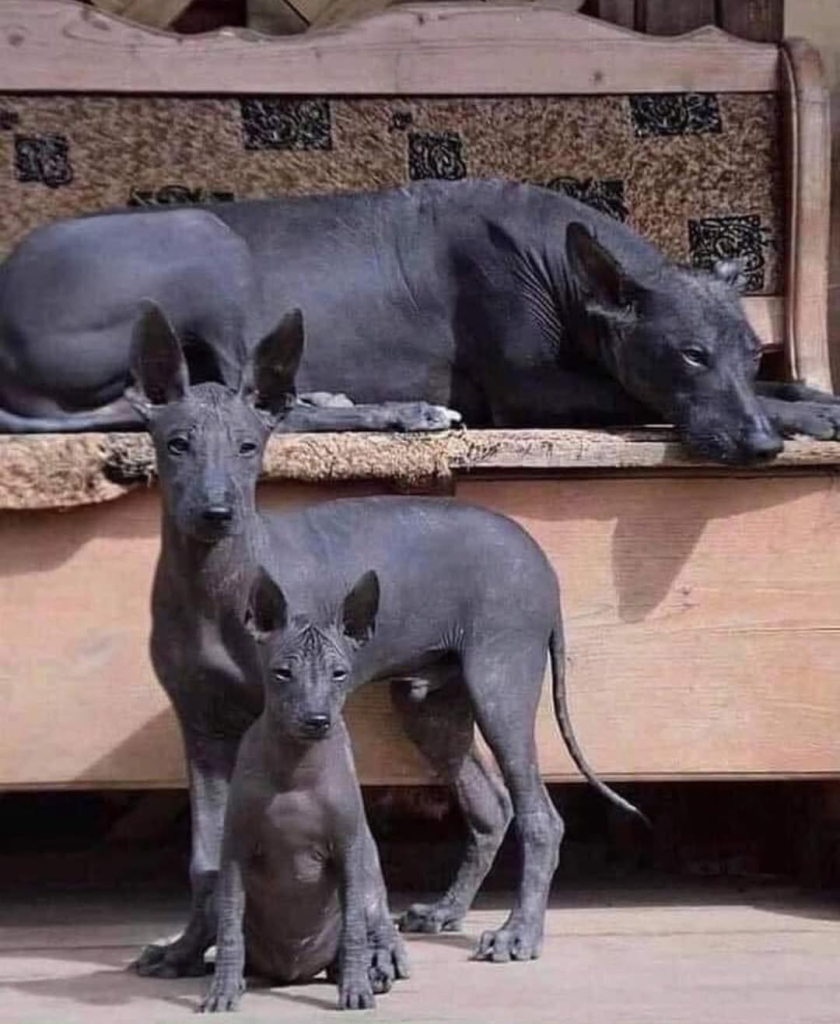They stand in a quiet group — sleek bodies, dark skin gleaming under the sun, their eyes alert and almost ethereal. This is a family of Xolos (Xoloitzcuintli), one of the most ancient and enigmatic dog breeds in the world. Their presence carries with it whispers of centuries, of myth and ritual, of life and death—connecting our modern gaze to a world long passed.
The Ancient Roots of the Xolo
The Xoloitzcuintli, often simply called “Xolo,” traces its lineage far back into pre-Columbian Mesoamerica. Archaeological finds—from ancient burial sites, clay sculptures, ceramic figures, and stone reliefs—reveal dogs bearing striking resemblance to today’s Xolos. These artifacts suggest humanity has long recognized these animals not just as companions, but as creatures laden with symbolic weight.
At the heart of their name lies a powerful myth. In the Nahuatl language of the Aztecs, Xolotl was a deity tied to death, lightning, twins, and darkness, while itzcuintli means “dog.” According to tradition, Xolotl fashioned the first Xolo from divine material and entrusted it to humans. Because of this, the Xoloitzcuintli became a sacred, liminal animal — straddling the worlds of the living and the spiritual.

Guardians of the Night and Guides of Souls
For many indigenous peoples in Mesoamerica, the Xolo was not merely a pet — it served as guardian of the night, protector against malign spirits, and guide through the underworld. In some traditions, when a person died, their soul faced a perilous path through a realm known as Mictlán, the land of the dead. The journey demanded crossing rivers, encountering fierce trials, and traversing darkness. It was said that only with a benevolent Xolo at their side could the traveler safely navigate this passage.
These beliefs were not casual metaphors. In practice, dogs were sometimes buried alongside their owners, or sacrificed so that together they might journey onward in eternity. In essence, the Xolo’s role bridged life and death, physical existence and spiritual voyage.
Symbolism Across Cultures — Then and Now
Over centuries, the Xolo’s image and role shifted. Through the rise and fall of Mesoamerican civilizations — the Toltecs, the Maya (in parts of regionally overlapping cultures), the Aztecs — these dogs endured as symbolic touchpoints. They appear in local art, in ritual objects, and even in everyday life.
One fascinating myth recounts that Xolos possessed healing abilities. Because their bodies lack fur, they naturally emit more body heat to the surface. In small, traditional communities, people sometimes used them as living “heaters” to provide warmth or comfort to the ill or elderly. While modern science does not validate mystic healing, there remains an emotional truth: companionship, warmth, and empathy from an animal can support emotional—and sometimes physical—wellbeing.
In more recent times, after centuries of marginalization, the breed has seen a revival. Mexico and dog-preservation groups have worked to reestablish the Xoloitzcuintli as both a national symbol and living heritage. Today, the breed is recognized by international kennel organizations, and dog lovers globally admire their distinct appearance, stoic demeanor, and deep cultural roots.
The Xolo in Modern Life: Challenges & Beauty
To meet a modern Xolo is to meet a paradox: elegant yet ancient, minimal in appearance but rich in symbolism.
- Varieties & appearance: Some Xolos are hairless, showing smooth, wrinkled skin. Others possess a light coat. Amazingly, both coated and hairless pups can appear in the same litter — a testament to their genetic complexity.
- Temperament: Xolos are typically calm, reserved, and devoted to their human families. They are not known for aggressive behavior but can be wary of strangers — guarding quietly rather than confronting loudly.
- Care needs: Hairless dogs require skincare: moisturizing, sun protection, and occasional baths. Their exposed skin is vulnerable to sunburn, abrasions, and temperature sensitivity.
- Cultural identity: In Mexico, the Xolo is more than a breed — it is a living emblem of indigenous heritage. Many people feel that caring for a Xolo is also caring for a culture and its memory.
Walking among that family of Xolos today, one senses more than dogs. One senses continuity.
One senses that, across centuries, through colonization, cultural suppression, and modernization, certain things endure: stories, symbols, bonds between human and animal. The Xolo survives because its meaning transcends utility. It holds within its skin a legacy — a tale of mortality, protection, and transformation.
As you observe details — the gleam of skin, the stillness of posture, the almost meditative gaze — you might wonder whether one of those dogs carries the silent weight of its ancestors. Perhaps, in a quiet moment, it bridges the gap between now and then.